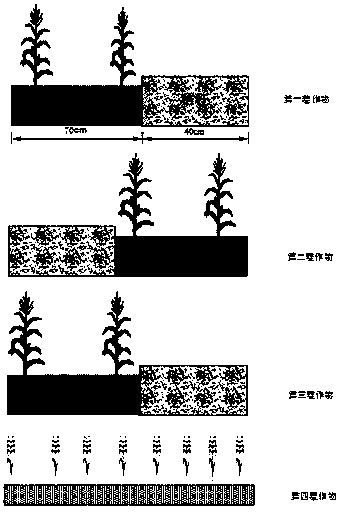Mulch-carrying straw returning and planting method of upland crops of loess plateau
A technology for dryland crops and the Loess Plateau, applied in the field of crop cultivation, can solve problems affecting the sowing quality and emergence rate of next crops, low soil temperature and moisture content, difficult to decompose corn stalks, etc., and achieve good crop yield and soil fertility effect, increasing soil water content, and increasing straw decomposition rate
- Summary
- Abstract
- Description
- Claims
- Application Information
AI Technical Summary
Problems solved by technology
Method used
Image
Examples
specific Embodiment
[0057] Specific technical solutions such as figure 1 As shown, it is especially suitable for planting in the dry land of the Loess Plateau in Gansu. It is carried out in rotation of spring corn-spring corn-spring corn-winter wheat. The first crop—spring corn, after the previous crop of wheat was harvested in mid-October, the stubble was plowed deeply in time, and the land was leveled by harrowing after plowing. At the beginning of May after the spring of the next year, divide the non-planting zone and the planting zone with wood or steel bars in the plot. The straw is crushed into 2-6cm, and every 667m 2 The amount of non-planting straw returning to the field is 500kg, and the soil layer is covered on the straw surface. Every 667m 2 Apply basal fertilizer, cover the planting belt and non-planting belt with film, and finally use a hole seeder to sow seeds in the planting belt. The corn is sown at a depth of 3-6 cm, with a plant spacing of 25-30 cm and a row spacing of 25-30...
PUM
 Login to View More
Login to View More Abstract
Description
Claims
Application Information
 Login to View More
Login to View More - R&D
- Intellectual Property
- Life Sciences
- Materials
- Tech Scout
- Unparalleled Data Quality
- Higher Quality Content
- 60% Fewer Hallucinations
Browse by: Latest US Patents, China's latest patents, Technical Efficacy Thesaurus, Application Domain, Technology Topic, Popular Technical Reports.
© 2025 PatSnap. All rights reserved.Legal|Privacy policy|Modern Slavery Act Transparency Statement|Sitemap|About US| Contact US: help@patsnap.com


